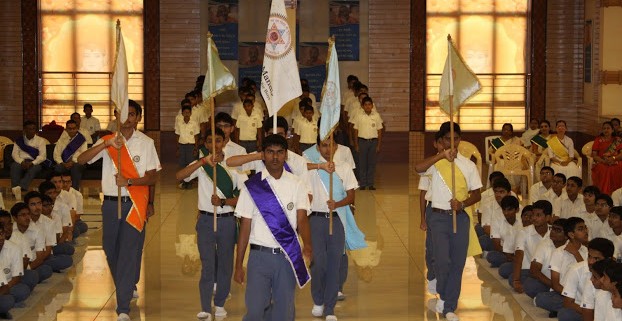Being blessed by Him to be better
His boundless love for the students called for an assembly (Sabha) which was held in the school prayer hall on 25th February 2014. The hall was brimmed with devoted heads and eager hearts as Swamishree addressed all with His kind and deep concern. To begin with, the students sang a heart stirring lyrical hymn… adding a bit edge to the ardent ambiance and there came a benign smile on Swamishree’s face as He listened to these prayers being offered to Him. Purvesh Sir handled the mic and being a zestful host of the programme, he shared a few incidences where students of AVM evidently practised ideal behaviour in classes, playground and in hostel. Soon after Vinamrabhai of Std 8th was invited on the stage to present a brief report on cultural activities through which lessons of harmony and the moral values are imparted to the students. Thereafter, Purvesh Sir specified a few more incidents stating how the very mission of the school “Union of Body, Mind and Soul” is being accomplished. This brought an appreciating and enchanting gesture on Swamishree’s face and His encompassing gaze left us in total bliss. After that Abhishekbhai Ariwala and Nileshbhai Yadav of Std 12th offered a prayer on behalf of all students and asked for His blessings in all their endeavours. It was followed by a much awaited and momentous opportunity for the students of class 12th to get one-to–one meeting with Swamishree. He was being affectionate, listening patiently to each one of them enveloping them in His divine aura and blessing them.
Then came the ever auspicious “better one day in your court than thousand elsewhere” moment, when Swamishree voiced His golden words. How convincingly yet persuasively He explained to the students that they should always be extremely respectful to their parents and withdraw instantly the very thought of aggressiveness towards elders in the family! Students listened very earnestly when Swamishree stressed over becoming God-Loving and adopting the habit of resorting to prayers in all times. Moreover, He strengthened their commitment and zeal for being better by insisting them to avoid watching distracting movies and keeping good company. Thus, Swamishree blessed students not only for a brilliant career but induced the contemplation to lead a fearless existence with righteousness, purity of intentions, positive thinking and focused mind.
If glorious sun shines above our head … what more light needed to be asked for? Seemingly Swamishree’s very presence among us exudes a powerful scent of serenity, how fortunate we are to be sheltered under His umbrella of love and enjoying the bliss!!!!!!!

